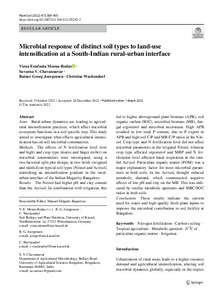| dc.date.accessioned | 2022-07-01T13:23:49Z | |
| dc.date.available | 2022-07-01T13:23:49Z | |
| dc.date.issued | 2022-03-01 | |
| dc.identifier | doi:10.17170/kobra-202204206050 | |
| dc.identifier.uri | http://hdl.handle.net/123456789/13980 | |
| dc.description.sponsorship | Gefördert im Rahmen des Projekts DEAL | ger |
| dc.language.iso | eng | eng |
| dc.rights | Namensnennung 4.0 International | * |
| dc.rights.uri | http://creativecommons.org/licenses/by/4.0/ | * |
| dc.subject | nitrogen fertilization | eng |
| dc.subject | carbon cycling | eng |
| dc.subject | tropical agriculture | eng |
| dc.subject | metabolic quotient | eng |
| dc.subject | δ¹³C of particulate organic matter | eng |
| dc.subject | irrigation | eng |
| dc.subject.ddc | 570 | |
| dc.title | Microbial response of distinct soil types to land-use intensification at a South-Indian rural-urban interface | eng |
| dc.type | Aufsatz | |
| dcterms.abstract | Aims
Rural-urban dynamics are leading to agricultural intensification practices, which affect microbial ecosystem functions in a soil-specific way. This study aimed to investigate what effects agricultural intensification has on soil microbial communities.
Methods
The effects of N fertilization level (low and high) and crop type (maize and finger millet) on microbial communities were investigated, using a two-factorial split-plot design, at two fields (irrigated and rainfed) on typical soil types (Nitisol and Acrisol) mimicking an intensification gradient in the rural-urban interface of the Indian Megacity Bangalore.
Results
The Nitisol had higher pH and clay content than the Acrisol. In combination with irrigation, this led to higher aboveground plant biomass (APB), soil organic carbon (SOC), microbial biomass (MB), fungal ergosterol and microbial necromass. High APB resulted in low total P content, due to P export in APB and high soil C/P and MB-C/P ratios in the Nitisol. Crop type and N fertilization level did not affect microbial parameters in the irrigated Nitisol, whereas crop type affected ergosterol and MBP and N fertilization level affected basal respiration in the rainfed Acrisol. Particulate organic matter (POM) was a major explanatory factor for most microbial parameters in both soils. In the Acrisol, drought reduced metabolic demand, which counteracted negative effects of low pH and clay on the MB. This was indicated by similar metabolic quotients and MBC/SOC ratios in both soils.
Conclusions
These results indicate the current need for water and high-quality fresh plant inputs to improve the microbial contribution to soil fertility at Bangalore. | eng |
| dcterms.accessRights | open access | |
| dcterms.creator | Moran-Rodas, Virna Estefania | |
| dcterms.creator | Chavannavar, Suvarna V. | |
| dcterms.creator | Jörgensen, Rainer Georg | |
| dcterms.creator | Wachendorf, Christine | |
| dc.relation.doi | doi:10.1007/s11104-021-05292-2 | |
| dc.subject.swd | Stickstoffdüngung | ger |
| dc.subject.swd | Kohlenstoffkreislauf | ger |
| dc.subject.swd | Tropen | ger |
| dc.subject.swd | Landwirtschaft | ger |
| dc.subject.swd | Partikulärer organischer Stoff | ger |
| dc.subject.swd | Bewässerung | ger |
| dc.type.version | publishedVersion | |
| dcterms.source.identifier | eissn:1573-5036 | |
| dcterms.source.issue | Issue 1-2 | |
| dcterms.source.journal | Plant and Soil | eng |
| dcterms.source.pageinfo | 389-405 | |
| dcterms.source.volume | Volume 473 | |
| kup.iskup | false | |


